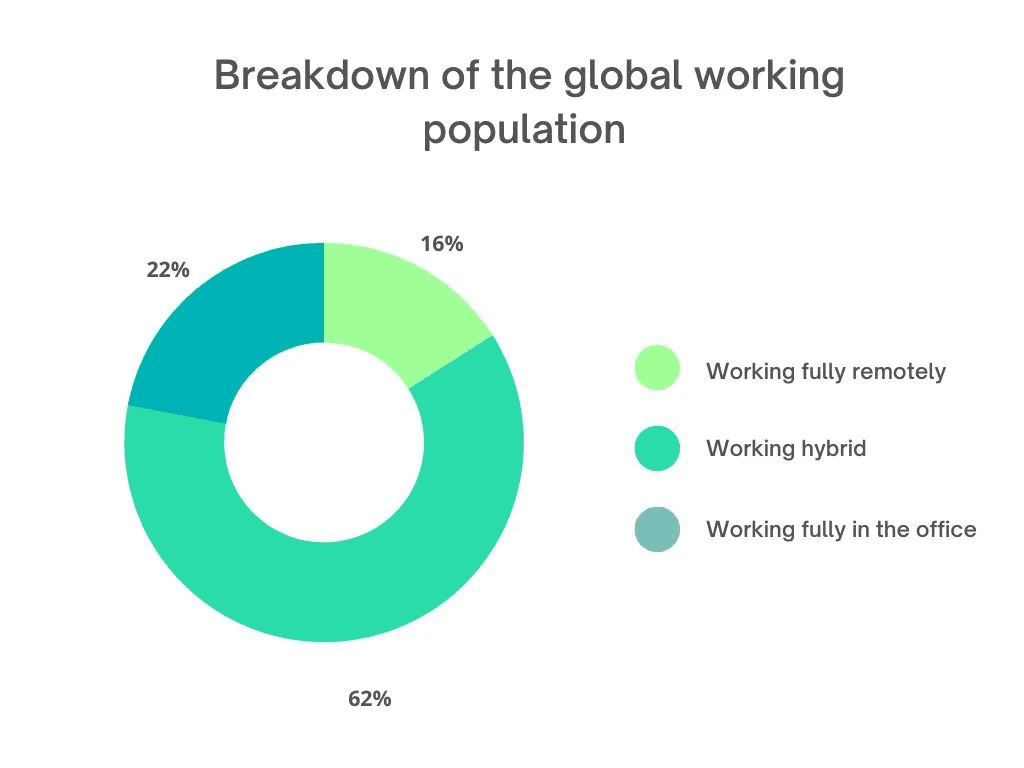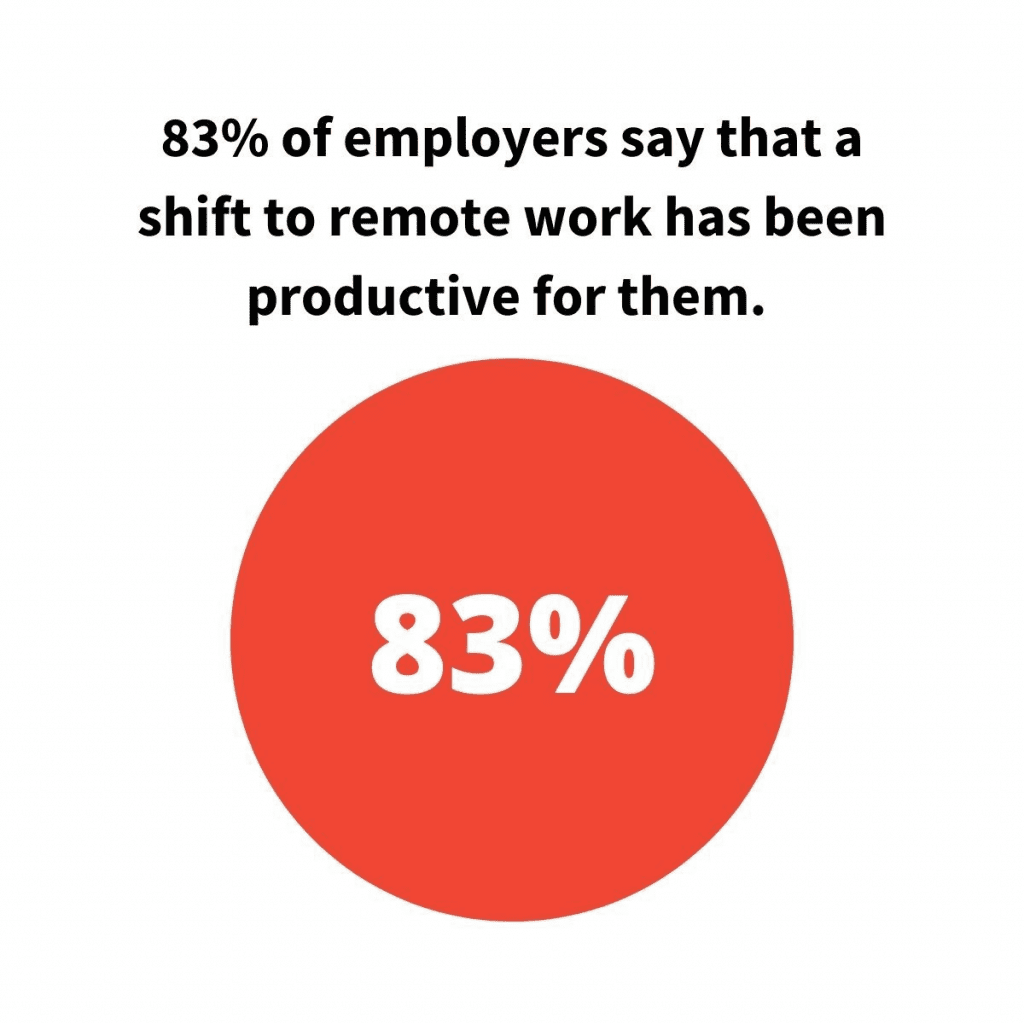As technology keeps shaping our lives and redefining how we communicate and collaborate, the way we work is undergoing a transformative shift. Professionals no longer want traditional office settings, as a new approach has emerged—the hybrid workplace model. It combines the best of both remote work and in-person collaboration and paves the way for a more flexible and adaptable future of work.
But what exactly is a hybrid workplace model? How is it different from the conventional 9-to-5 office routine or the remote work setup that became so popular during the Covid-19 pandemic?
These questions are at the forefront of discussions about the future of work as businesses and employees look for a balance that maximizes productivity, enables employees to achieve work-life balance, and supports employee well-being.
In today’s post, we’ll explore the hybrid workplace model’s benefits, challenges, and tips to use it more effectively.
So, keep reading as we are going to uncover the possibilities and implications of this evolving work model that has the potential to revolutionize how we approach work in the years to come.
What is a Hybrid Workplace Model?
As we have already mentioned, the hybrid workplace model is a mix of remote and in-office work. This digital workplace model has gained huge popularity after the Covid-19 pandemic. Many companies adopted a hybrid workplace model. It gives employees the flexibility to work from both home and a physical office, providing a balance between the convenience of remote work and the benefits of face-to-face collaboration.
Below you can find a report done by Owl Labs in 2021 which shows the breakdown of the global working population.

Source: https://www.neuroworx.io/magazine/hybrid-work-statistics-what-the-future-of-work-looks-like/
Due to advanced technology and communication tools, professionals can easily connect and contribute no matter where they are. This model also enables employees to choose the work environment based on their needs, preferences, and tasks.
The hybrid workplace model is revolutionizing how we work and adapt in a rapidly changing world due to its ability to blend the best aspects of remote work and office work.
Benefits of the Hybrid Workplace Model
1. More Flexibility for Employees
At least once in your life, you have wanted to work from any location you want but could not because of your in-house work. The great news is that with hybrid work, both physical and virtual office options are available.
Hybrid work allows employees to create a work schedule that suits their individual needs. Whether you are an early bird or a night owl, you can organize your day the way you want. This flexibility will lead to having a better work-life balance, as you have a chance to live your life to the fullest, do your hobbies, and spend time with your family.
Besides, different employees have different working styles. Some people thrive in the buzz of collaborative office space, while others prefer to work in silence. Therefore, it is highly recommended to let employees choose the setting that fosters their best work and maximizes their potential.
Flexibility will also reduce employee burnout. Imagine the workers who live far from the office. They need to wake up early in the morning and spend more than an hour commuting to work.
This is indeed a repetitive, tiring, and anxious process, which can take all the energy from your employees. As a result, they will lack the motivation to work and complete even the simplest tasks.
So, adopting the hybrid approach is definitely worth it. After all, it is happy employees that bring the most benefit to your company.
2. Hybrid Workplace Model Enhances Productivity
Flexibility is another key advantage of the hybrid workplace model. Letting employees choose where and when they work empowers them to optimize their productivity. There is no need for a daily commute, which frees up valuable time and minimizes stress. This is a great way to handle work stress and achieve great employee performance.
In fact, PwC’s survey of 133 executives showed that 83% of employers say that switching to remote work has been productive for them.

Source: https://codesubmit.io/blog/hybrid-workplace-statistics/
This flexibility also enables employees to create personalized work environments that suit their preferences and work styles. Whether it is a noiseless home office or a busy coffee shop, employees can choose the setting that best matches their focus and productivity needs for a particular task.
The hybrid workplace model also lets employees work and enjoy their lives. When there is no traditional 9-to-5 office setup, employees tend to manage personal responsibilities and commitments better. This leads to reduced burnout and increased overall employee satisfaction. A happy and fulfilled workforce is more motivated, engaged, and productive.
3. Cost-Friendly Solution for Businesses
By mixing remote and in-office work, this model offers a win-win situation for both employers and employees. How, you may ask?
The hybrid workplace model reduces expenses. When some of the employees work remotely, businesses can downsize their physical office space. In other words, companies save on rent, utilities, and maintenance costs.
Hybrid work financially benefits both employers and employees. Workers can save on fuel, parking fees, and public transportation expenses.
Remote work also opens up opportunities for hiring talent from different locations, including places with lower living costs. For instance, a marketing agency based in a high-cost city embraces remote work and hires a skilled graphic designer from a different country where living costs are lower. By offering a competitive salary based on the designer’s local standards, the agency saves on recruitment and relocation expenses while accessing top talent from a global pool.
This enables businesses to delve into a global talent pool and find professionals at competitive salaries. By increasing their talent acquisition reach, businesses can save on recruitment and relocation expenses.
Also read: How Freelancing Boom Is Pushing Businesses To Hybrid Work Model
Challenges of the Hybrid Workplace Model
1. Company Culture and Connectedness
Building and maintaining a strong company culture, as well as building a sense of connectedness among employees, can be a hurdle in a hybrid workplace. When team members are working from diverse locations, it becomes essential to find alternatives to develop a shared identity and promote collaboration.
To build stronger bonds between your workers, you can organize regular virtual team-building activities and online social events.
Social interaction is an integral part of working culture, even if it is a short chat with a teammate. It promotes well-being and cooperation and increases morale, but with hybrid workforces, employees can feel isolated.
Informal events, such as team gatherings outside the workplace, are a great opportunity to unite everyone under one roof. You could also hold virtual events to maintain social interaction. This will contribute to better relationships, strengthen bonds, boost collaboration, and make employees feel like they belong.
As for the virtual events, make sure to use the right technology so that employees can have a seamless communication experience.
2. Poor Communication
Effective communication is crucial for any company’s success, and the hybrid workplace comes with communication challenges. Miscommunication, late responses, and lack of information can occur when employees are not working in the same physical location.
To solve this issue, companies should establish clear communication protocols, encourage the use of collaborative tools like business phone system, and provide training about how to make the most out of these tools. This can be done as part of an internal communication strategy. A well-crafted internal communication strategy could be the catalyst in improving employee engagement and subsequently, the company’s bottom line. It involves meticulously planning how, when, and through what channels you communicate internally, inevitably fostering better collaboration and understanding among hybrid employees. Companies should also use the best communication channels. They can create an app to be in constant touch with hybrid employees and facilitate seamless communication. An app specifically designed for internal communication can serve as a dedicated platform for hybrid employees to stay connected and engaged with their peers and managers.
Organizing regular check-ins, both individual and group discussions on a team communication app, can help keep everyone on the same page and make sure that important information is shared efficiently. Besides, such meetings can allow team leaders to set clear goals and expectations for their employees, which can further enhance communication effectiveness. Last but not least, regular meetings are a great way to give and receive feedback. This way, employees will know what they are good at and what should be improved.
3. Inequality Between Hybrid and Non-Hybrid Workers
Another challenge of the hybrid workplace model is the risk of creating inequality between hybrid and non-hybrid workers. Non-hybrid employees who are obliged to be physically present in the office may perceive disadvantages compared to their remote counterparts. To avoid this, companies should ensure that both hybrid and in-office workers have equal access to resources, opportunities, and decision-making processes.
For instance, imagine a company organizing team-building activities only for remote employees, ignoring the non-hybrid workers who are unable to participate due to their on-site obligations. This may lead to feelings of isolation and resentment among non-hybrid employees and affect their motivation and job satisfaction.
To avoid such cases, companies can create policies that encourage flexibility in work arrangements, enabling non-hybrid employees to have the option of working remotely on particular days. By providing this opportunity, the company ensures that all workers can experience the benefits of remote work and avoid the perception of favoritism towards hybrid workers.
Also read: The Future of Work: Freelancing vs 9-5 Jobs
5 Tips for Embracing the Hybrid Workplace Model
1. Prioritize the Well-Being of Employees
As we have already mentioned, a happy workforce can help your company grow. On the other hand, dissatisfied and stressed workers can have little or no impact on your company. Therefore, it is essential to prioritize the mental health of your employees.
The best way to do this is to provide employees with assistance programs, counseling services, and mental health resources. You can also hire a health and wellness specialist to provide training on stress management and resilience. Such training can help your staff to express their thoughts and concerns openly. As a result, you will know what bothers your workers the most and try to find relevant solutions or you can choose a more cost-effective way by working on a training video production for this training to be available in video format to all employees.
Apart from mental health, you should also pay attention to the physical wellness of your employees. Promote regular physical activity, provide resources for hybrid employees to set up ergonomic home offices, and encourage regular short breaks for some physical activities such as stretching or cycling. You can also organize virtual fitness classes or wellness challenges to keep employees engaged and motivated.
2. Provide the Right Tools for Remote Collaboration
Effective remote collaboration is crucial for a successful hybrid workplace. It is possible only via reliable communication and collaboration tools that will provide seamless virtual interactions.
Among the tools crucial for supporting a hybrid work environment, AI-powered employee intranet solutions offer unique advantages. They streamline information sharing and collaboration, irrespective of employees’ physical locations. A feature-rich intranet can significantly improve organizational knowledge management.
Consider using platforms like cloud-based video conferencing, project management software, and instant messaging platforms to enable effective teamwork and ensure that remote employees feel connected and engaged and there is no communication gap between employees and employers.
Slack is a popular collaboration tool that has significantly increased productivity for companies worldwide. For instance, Airbnb, Spotify, Pinterest, and other companies implemented Slack to streamline communication, resulting in faster decision-making, enhanced teamwork, and improved overall productivity.
With these tools, employees can collaborate on projects, share their creative ideas, and stay updated on how the project is progressing. However, it is also essential to educate employees about how to use these tools to be able to get the most out of them.
By providing the right tools for seamless remote collaboration, you enable effective communication, boost productivity, and enhance the overall hybrid work experience.
3. Take cybersecurity and data protection measures
The hybrid workplace model assumes using digital tools and having remote access. This means that cybersecurity should be taken into consideration. In other words, businesses should take robust security measures to protect sensitive and confidential information.
Among security measures are using secure networks, strong password protocols, and conducting cybersecurity training for employees. Additionally, using the best privacy browser iOS can further enhance online security and protect sensitive information from potential threats and data breaches. Besides, businesses should regularly update security systems and perform security audits to detect and address potential vulnerabilities.
Data protection is also possible in the case of implementing encryption and access controls to protect critical information. Additionally, businesses can set clear security policies that highlight
security protocols and guidelines for employees to follow.
By prioritizing cybersecurity and data protection, you can instill confidence in employees, clients, and stakeholders, ensuring the secure and uninterrupted operation of your hybrid workplace.
4. Empower employees to make decisions
In a hybrid workplace, letting employees make decisions fosters a sense of ownership and accountability. When you create a culture of trust where employees have the freedom to make decisions, they feel more responsible when it comes to doing a particular task. This not only boosts employee morale but also improves the decision-making process.
For example, a store manager can empower a sales representative by allowing them to make decisions on resolving customer complaints. When customers have issues, instead of immediately stepping in to handle the situation, the manager encourages the employee to take ownership of the problem. In this case, the employees will need to use their knowledge and experience to handle the situation and make sure the customer does not leave the store with a sad or angry face.
Additionally, when delegating certain tasks, make sure to provide clear guidelines and boundaries, along with the necessary resources and support, to allow employees to take ownership of their work and do their best to complete certain tasks.
5. Invest in Employee Learning and Development
Continuous learning and development are also crucial in the work environment, be it in-office or hybrid. Therefore, it is essential to allocate resources and hold training tailored to the specific needs of both remote and in-person employees.
Upskilling and reskilling are important to ensure that employees have the necessary knowledge and skills to complete tasks within the hybrid workplace. You could use an Upskilling and Reskilling Platform for the same. Such investment in professional growth not only boosts employee satisfaction but also leads to organizational success.
So, let employees grow. As the famous saying goes, “Learning never exhausts the mind.” Whether it is in the form of online training modules, webinars, workshops, and mentorship programs, make sure your employees learn something new. You can also motivate employees to pursue self-directed learning and provide them with an opportunity to earn professional certifications or courses relevant to their roles.
Conclusion
Using the hybrid workplace model comes with both benefits and challenges. The key is how businesses are adopting new work models and whether their approach is successful. The hybrid workplace model does not work for all companies. Some companies manage to succeed, whereas others find it difficult to cope with the challenges caused by the hybrid workplace.
In any case, we hope this guide was useful for those who are looking to integrate the hybrid workplace model into their business. By following the above-mentioned five key tips, both businesses and employees can navigate the complexities of this new work paradigm with ease.


















